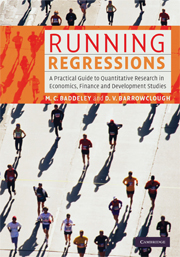 Running Regressions
Running Regressions Book contents
- Frontmatter
- Contents
- List of figures
- List of tables
- List of boxes
- Acknowledgements
- List of acronyms
- How to use this book
- Part I Simple regression and data analysis
- Part II Multiple regression and diagnostic testing
- 5 Multiple regression analysis
- 6 Heteroscedasticity
- 7 Autocorrelation
- 8 Model misspecification
- Part III Time-series econometrics
- Part IV Advanced topics
- Index
- References
8 - Model misspecification
Tobin's q and investment in the USA
Published online by Cambridge University Press: 05 June 2014
- Frontmatter
- Contents
- List of figures
- List of tables
- List of boxes
- Acknowledgements
- List of acronyms
- How to use this book
- Part I Simple regression and data analysis
- Part II Multiple regression and diagnostic testing
- 5 Multiple regression analysis
- 6 Heteroscedasticity
- 7 Autocorrelation
- 8 Model misspecification
- Part III Time-series econometrics
- Part IV Advanced topics
- Index
- References
Summary
Economic issues include:
Tobin's q theory
The Efficient Markets Hypothesis
Psychology, behavioural economics and neuroeconomics
Econometric issues include:
Identifying correct functional form
Model misspecification errors
Ramsey's RESET tests for model misspecfication
Data issues include:
Measuring stock market value
Measurement error
The issue
In this chapter, stock market valuation methods of investment appraisal are introduced and applied to US fixed asset investment data. In a simple world, business entrepreneurs use two factors of production when they are producing their goods and services: capital and labour. Fixed asset investment is about the first. As businesses invest in new plant, machinery and equipment they generate a flow of new capital goods into the stock of capital. This capital stock (when combined with labour inputs) will determine the future productive capacity both of the firm at a microeconomic level and of the macro-economy as a whole.
Some early investment theories focused on investment as the outcome of firms balancing the marginal benefits and marginal costs of buying units of new capital but these theories could not easily explain the timing of investment decisions. Also, they neglected the role of expectations and uncertainty. This was an important omission because investment is all about planning for the future: expectations and uncertainty have crucial impacts on entrepreneurial decision-making. The problem is that expectations are not observable and so one solution is to use stock market data on market capitalisations to capture investors' expectations about the future, as explained below.
- Type
- Chapter
- Information
- Running RegressionsA Practical Guide to Quantitative Research in Economics, Finance and Development Studies, pp. 178 - 198Publisher: Cambridge University PressPrint publication year: 2009


